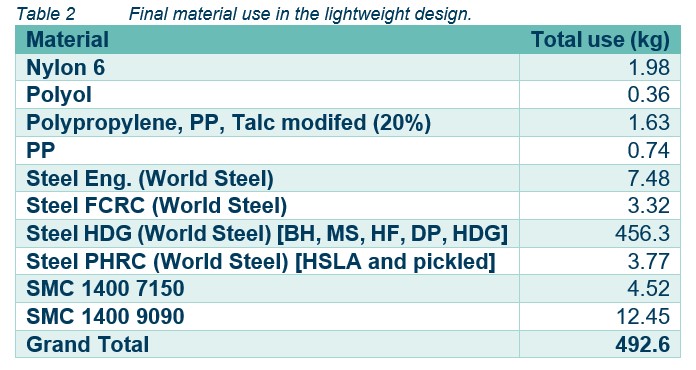In 2021, ALMA proposed a lightweight electric vehicle for passenger cars based on advanced light materials with reduced environmental impacts. The objective is to save materials, energy use and reduce carbon emissions associated with the vehicle’s entire life cycle.
This vision and commitment has been fulfilled:
✅ALMA BEV’s body-in-white (BiW) is 160kg lighter, representing an over 20% weight reduction compared to the baseline BEV BiW.
✅Over the car’s entire service life, the use of other materials and weight reduction contributes to a total reduction of 1850 kg carbon dioxide equivalent (CO2-eq), a 24% decrease in emissions.
Download the latest ALMA brochure here
Aside from these, the ALMA project also successfully applied the eco-design approach with BEVSIM’s LCA and LCC tool. The BEVSIM evaluated environmental impacts of materials at each stage, allowing us to make informed decisions regarding the “right materials for the right application”. ArcelorMittal developed and finetuned innovative products, such as Advanced High Strength Steels (AHSS) and steel laminates for lightweighting vehicle structure. Efficient manufacturing processes and Multi-Part Integration concepts helped reducing references and material usage.
Fraunhofer ITWM demonstrated that their simulation methods make it possible to experiment with many material models, minimising the need for experimental calibration, thereby saving time and resources. BATZ conducted a thorough analysis of vehicle structure to optimise components and systems, prioritising lightweighting using SMC composites.
To enhance circularity, RESCOLL’s innovative reversible assembly method, utilising debondable adhesives and primers like INDAR successfully demonstrated bonding and debonding on the composite part of the battery tray through a robotised program. Innerspec’s structural monitoring system, using acoustic signature analysis, is able to assess wear and potential damages like delaminations and porosity in composites.
Finally, on recyclability and recovery of materials, ArcelorMittal successfully demonstrated the recyclability of Fortiform S1270 through recycling trials and confirmed that Ultimate (Laminate) steel sheet does not release plastic fragments during shredding. TNO conducted the recycling and recovery of composite materials through solvolysis and pyrolysis processes, demonstrating that the quality of recovered materials showed good potential for re-use, either in new materials, or, as in the case of pyrolysis, to fuel the process.
The project results were published in a brochure and some physical demonstrators (ArcelorMittal’s H-Frame and Door Ring) were showcased, as part of the Enlight EVs cluster, at the Global Automotive Components and Suppliers (GACS) Expo between December 5-7, 2023 in Stuttgart, Germany.
In this article, our focus will be on the LCA/LCC tool BEVSIM (Battery Electric Vehicle Sustainability Impact Assessment Model) that was developed to support engineers and designers in designing a vehicle with good environmental performance.
BEVSIM LCA/LCC
The LCA-based application of BEVSIM allows users to model the materialisation of, for instance, a certain body-in-white design in BEVSIM, receive feedback on the associated environmental impacts and compare it with a selected reference design. The BEVSIM supports modelling a full car, a sub-system, or a part for LCA, LCC, Circularity Analysis. It is designed accessibility and user-friendliness for even non-LCA experts.
Besides the environmental impact, the Cumulative Energy Demand and life cycle costing (LCC) results can be also shown and compared with the selected reference.
Reference and lightweight design
The reference and lightweight design included the following subsystems:
- Battery system
- Upper body structure
- Front end
- Underbody
- Closures and lids BiW
- Side doors BiW
- Bumpers and spoilers
In order to achieve weight reduction and lower energy use in the lightweight design, HDG steel was replaced by sheet moulded composites (SMCs) resulting in a reduction of 156.9 kg, or a 24% lower mass of the same vehicle (subsystems). Table 1 and Table 2 present the material use for the reference and redesigned lightweight ALMA BEV.


Evidently, the BEV redesign has significant impacts: Nearly 1,850 kg of carbon dioxide equivalent (CO2-eq) was reduced over the vehicle’s full service life, representing a reduction of 24% compared to the carbon footprint of the reference.
In absolute terms, the largest reduction is found for the use phase of the vehicle as a lower mass results in a lower energy, electricity, consumption during the service life of the vehicle (see Figure 1). Additionally, steel use reduction further reduces the carbon footprint due to the use of materials.

BEVSIM uses Ellen MacArthur Foundation’s Material Circular Indicator (MCI)
For material circularity assessment of the designs, BEVSIM uses the material circularity indicator (MCI) from the Ellen MacArthur foundation, one of the first organisations to promote the need for a circular economy.
An MCI of 0 indicates that all materials in a design are lost at the end-of-life, a value of the MCI of 1 indicates full circularity without unrecoverable waste. The reference design had an MCI of 0.794, mainly due to the efficient recycling of steel. As a significant part of the steel is replaced by still difficult to recycle composites, the MCI of the lightweight design is somewhat reduced to a value of 0.776.

Due to the reduction of steel consumption and due to the lighter weight of the vehicle the environmental performance of the lightweight design has improved on average 25%, as can be seen in Figure 2.
In summary, the lightweighing of the vehicle redesign by reducing the steel mass and incorporating SMC composites led to a notable improvement in the electric vehicle’s carbon footprint and environmental performance. Although there’s a slight reduction in design circularity, the overall benefits of the redesign outweigh this drawback.

